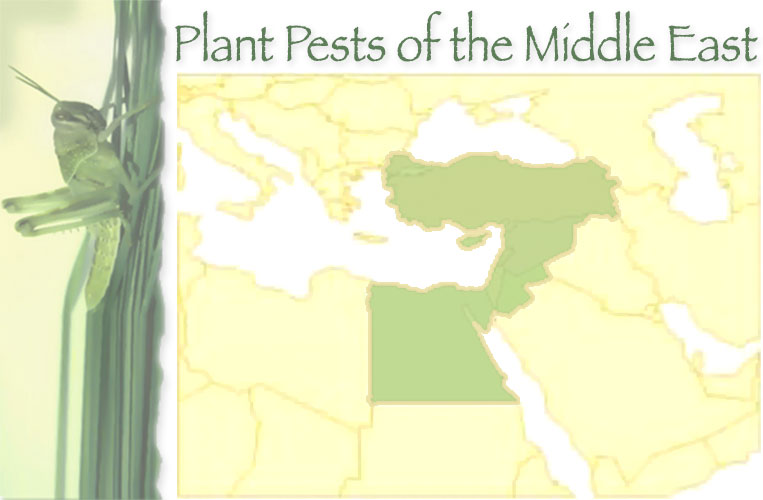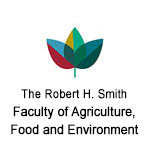
November 2019
Welcome to "Plant Pests of the Middle East"
This compilation of Plant Pests of the Middle East (PPME) is long overdue. Agriculture in the Middle East has much in common with agriculture in other parts of the world, but with many distinct characteristics. The same can be said about the pests in this region. Some have originated or are found in other parts of the world, whereas others are endemic to the Middle East. Considerable information of the different pest species, their relative importance, and on measures taken to control them, has accumulated in this region, with agriculture intensifying and changing its focus. Understanding pest-plant and pest-pest interactions in the agro-ecosystems in this region, and their effects on specific crops, is essential for maintaining good agricultural practices and balancing the needs of the agricultural community with the demands of the general public, from both economic and environmental points of view.
Accessibility of information is a major concern: Published books and scientific journals are costly whereas unpublished reports are usually unavailable. Information printed in books is often outdated, almost from the time of publication, and is not updated until new editions appear, if at all. Commercial considerations of publishing, such as the costs of color photographs and graphic art, limit their incorporation into conventional books. These reservations do not apply to this online freely accessible "virtual" publication.
The editor (Uri Gerson) is from the Department of Entomology, The Robert H. Smith Faculty of Agriculture, Food and Environment, of the Hebrew University, located at Rehovot, Israel. His scientific activities can be found in his institutional website, and the most convenient way to contact him is by e-mail: (uri.gerson@mail.huji.ac.il. Work on this website was initiated and partially co-edited by the late professor Shalom W. Applebaum, who regrettably passed away in the early stages of this endeavor. His obituary can be found in Phytoparasitica 40: 205–206 (2012). This project is dedicated to his memory.
PPME is intended for undergraduate and postgraduate students in agriculture, or researchers in plant protection, and is also suitable for extension workers, informed farmers and non-professional readers who are interested in the subject. More information is available in the websites appended to most pest (and sometimes Glossary) chapters. To assist the reader, "highlighted" terms and concepts are summarized in the Glossary.
Due to the vast amount of information available about certain major pests (like the desert locust or the Mediterranean fruit fly), only a limited number of these publications could be mentioned, although many more were consulted. An effort was made to include the more recent data and those publications that discuss different modes of pest control, especially those from the Middle East. These sources are included in the references listed for each chapter but not cited in the text; it is envisioned that such chapters will have to be modified and updated when new information becomes available.
Due to the use of different vernacular names applied to many pests covered in PPME, the Index is arranged according to the scientific names of the main groups, orders, families and species. Their more common vernacular names are included in the appropriate species chapters.
The composing and editing of PPME is an ongoing, open-ended process; the editor will thus welcome readers who wish to comment, correct and add to the presentations.
This project could not have been accomplished without the encouragement and support of present and past Deans of the The Robert H. Smith Faculty of Agriculture, Food and Environment, of the Hebrew University, located at Rehovot, Israel. In addition, I am pleased to acknowledge the help and support offered by many colleagues, especially Professor Z. Mendel and Drs. Y. Argov, D. Blumberg, Y. Gazit, Y. Rossler, A. Uziel and Mr. Y. Drishpoun, who provided some texts and original photographs.
Finally I wish to express my deep appreciation to Mrs. Deborah Weisman of the Computer Center at our Faculty, for the unstinting assistance that she has given me throughout. Without her ongoing support PPME would never have happened.
Several textbooks and key publications that deal with insects and mites in general, or with plant pests in the Middle East in particular, have been used throughout these texts, often without referring to them specifically. They include:
Avidov, Z. and Harpaz, I. 1969. Plant Pests of Israel. Israel Universities Press, Jerusalem.
Cohen, M. 2000. A Guide to Integrated Pest Management of Stone Fruits in Israel. Pest Identification, Monitoring and Treatment Thresholds. Ministry of Agriculture and Rural Development, Extension Service. (In Hebrew).
Gullan, P.J. and Cranston, P.S. 2005. The Insects; an Outline of Entomology. Blackwell Publishing.
Kaspi, R., Drishpoun, Y., Gross, S. and Rotman, N. (eds) 2017. Citrus Pests and Their Natural Enemies in Israel. Ministry of Agriculture and Rural Development, Extension Service. (In Hebrew).
Öztemiz, S. and Doğanlar, M. 2005. Invasive plant pests (insect and Acarina) of Turkey. Munis Entomology and Zoology 10: 144-159.
Oppenheim, D. (ed.) 1994. A Guide to Integrated Pome Pest Management in Israel. Ministry of Agriculture and Rural Development, Extension Service, (In Hebrew).
Swirski, E., Wysoki, M. and Izhar, Y. 2002. Subtropical Fruit Pests in Israel. Fruit Board of Israel. 283+III (in Hebrew with an English Preface).
Talhouk, A.M. 2002. Insects and Mites injurious to Crops in Middle Eastern Countries. 2nd Edition. American University of Beirut Press.
Vacante, V. and Gerson, U. 2011 (eds). Integrated Control of Citrus pests in the Mediterranean Region. Bentham Science Publishers EBooks.
